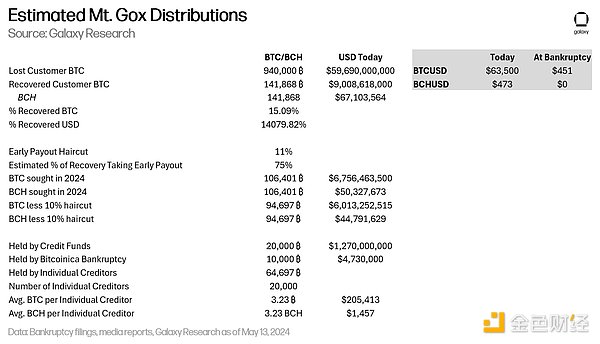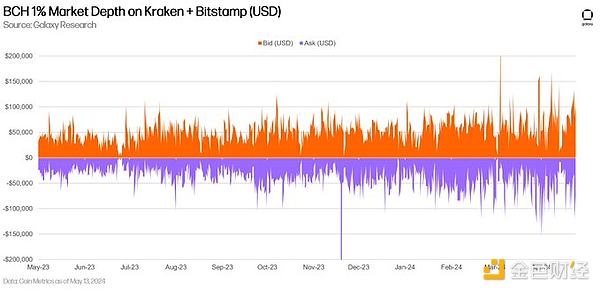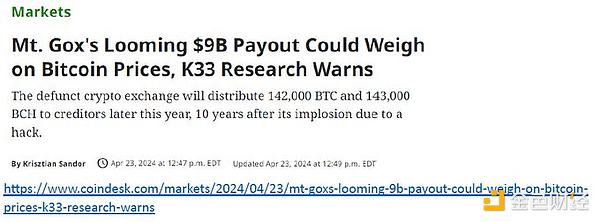Author: Alex Thorn, Head of Research at Galaxy; Compiler: 0xjs@黄金财经
Creditors have been trapped in the Mt.Gox bankruptcy case for more than 10 years - finally the trustee said that the physical distribution of BTC and BCH will begin in July.
We believe that the number of tokens distributed will be less than people think, and it will cause less Bitcoin selling pressure than the market expects. Here are the reasons:
The data in this article is based on reviewing bankruptcy filings, conversations with creditors, and various assumptions. Please note that these are estimates and are intended to provide direction rather than certainty. This is not investment advice, please do your own research.
Mt.Gox compensation BTC distribution details How much BTC will be sold
On May 13, I sent a notice to Galaxy customers and counterparties detailing some numbers, see the summary chart below.

Mt.Gox lost about 940,000 BTC (US$424 million at the time) and recovered 15% (141,868 BTC, or about US$63.9 million at the time), now worth US$9 billion. Although only 15% was recovered, it was a 140x gain for creditors in USD. In order to get early payout, creditors accepted a ~10% write-down. We believe ~75% of BTC creditors chose this option, ~95,000 BTC for early payout.
Of these, about 20,000 bitcoins go to the claims fund, about 10,000 bitcoins go to Bitcoinica BK, and the remaining about 65,000 bitcoins go to individual creditors. 65,000 BTC/BCH is far less than the 141,868 bitcoins regularly published by the media.
But there are reasons to believe that individual creditors will be more inclined to hold bitcoin than the market expects:
1. Creditors are clearly long-term bitcoin holders. They are tech-savvy early adopters.
2. For years, individual creditors have resisted compelling and aggressive offers from the claims fund, indicating that they want their bitcoin back, not dollar-denominated compensation.
3. The impact of the sale on capital gains will be huge. As prices rise, despite only 15% physical recovery, the Bitcoin (in US dollars) recovered by creditors has risen 140 times since the bankruptcy.
That is, even if only 10% of the 65,000 Bitcoins are sold, 6,500 BTC have been dumped on the market and are likely to be sold on the market. Creditors will receive Bitcoin in accounts at Kraken, Bitstamp or Bitgo, and most individuals will deposit it directly into Kraken or Bitstamp trading accounts.
Some thoughts on the claims fund. My understanding from talking to some of them is that the vast majority of LPs in these funds are high net worth Bitcoin holders seeking discounted BTC, rather than credit funds doing arbitrage trading. While some LPs will certainly sell, I don’t think these funds are primarily made up of traders seeking arbitrage. BCH selling pressure will be much greater than BTC BCH may perform much worse than BTC from the Mt.Gox distribution. 1. No creditors initially purchased BCH. The recovered BCH originated from the fork of Mt.Gox using its BTC key Claim, which occurred several years after Mt.gox went bankrupt. 2. BCH liquidity is very low. $400k of liquidity on the order book is within 1% of the market price.
3. Liquidity is even thinner if we only look at Kraken and bitstamp, where individual creditors will receive tokens. BTC has 60x the liquidity of BCH on these exchanges.
 Therefore, I believe that the amount of currency distributed is lower than the market expected (see all types of titles).
Therefore, I believe that the amount of currency distributed is lower than the market expected (see all types of titles).

And I think that once these crypto tokens are distributed, BCH will perform worse than BTC - a large part will be sold by creditors into a market with less liquidity.
 JinseFinance
JinseFinance


 Therefore, I believe that the amount of currency distributed is lower than the market expected (see all types of titles).
Therefore, I believe that the amount of currency distributed is lower than the market expected (see all types of titles). 







